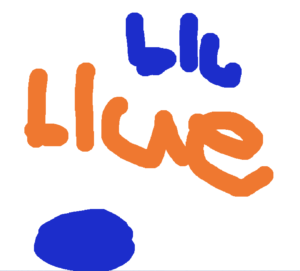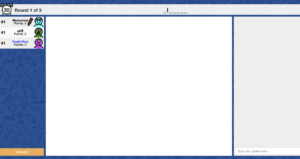Skribbl.io reimagines the classical pictionary game in a digital format, and in doing so, provides players with many more customization and play options than classic pictionary. Given that our game was building off of a mix of charades, pictionary, and other social party games, I felt testing this game could teach valuable lessons on different functional elements of the game.
Constraints were a big topic of discussion for my group, and it’s been very difficult to really assess what level of restriction is appropriate for the game to feel fluid. Skribbl.io seems to go more for giving users as many unrestricted actions as possible as opposed to the classic pictionary game. In skribbl.io, constraints aren’t explicitly laid out, but rather moderation of what is fair and allowed is left up to the other players who get to “thumbs up” or “thumbs down” the drawer to provide feedback on whether they’re remaining within game rules. The lack of constraints here really hinders gameplay as for some rounds, the word is simply drawn out explicitly which drastically removes the problem-solving fun of the game. For example, when one of my friends had the word “blue,” this was the drawing they put out:

Obviously, everyone was able to guess the word with ease, and the “thumbs down” mechanic did very little to mitigate this, which leads me to think of more explicit ways to define constraints in our game.
I’d define fellowship fun as a key contributor to both skribbl.io and our game, and the stylistic choices to enhance the fellowship experience in skribbl.io feel very dynamic and seem particularly valuable to an online setting. Prior to getting into a game, players are able to customize their avatar in order to distinguish each other. Though, in practice, the execution feels a little underwhelming as many of the avatars look the same, I think if more detail was put into this feature, player identity would definitely grow significantly and it would feel more personal. Within the context of our game, though player customization can’t really be adapted to an analog format, I believe having some sort of method for players to integrate themselves with the game will be extremely valuable. This can be done in the context of having players fill in empty game cards to add their voices into the gameplay process, or even define some of their own game mechanics, sort of like “house rules” for Uno to allow the game to feel a little more personal and as a result more engaging.
![]()
Lastly, what I found particularly immersive for the gameplay experience was the minimalistic design of the game overall. The focus of the game is on the artwork that players create, and thus the game is designed in a way where there are minimal distractions, and the artwork of players can be put into focus. This minimalism is definitely something to consider in our group’s own game design. Below is the simple interface for skribbl.io which allows drawing as the focal point:

The focal point of our game is movement, and the kinesthetic components of the game should be emphasized while all other reactions are reduced as much as possible. Thus, we will aim to minimize the game materials, and incorporate a minimalist approach to the game materials where they are still aesthetically pleasing, but don’t pose as distractions for the game.


